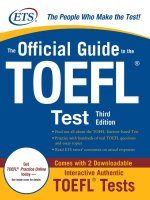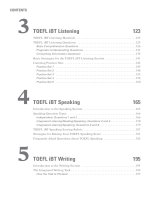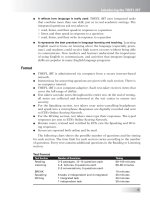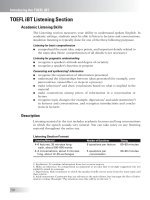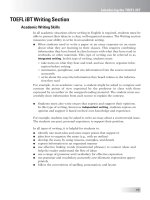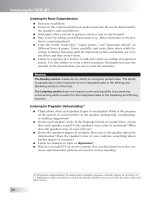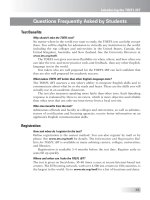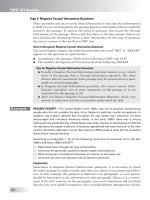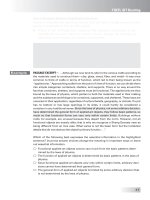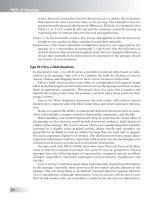The official guide to the toefl ibt third edition part 7 ppsx
Bạn đang xem bản rút gọn của tài liệu. Xem và tải ngay bản đầy đủ của tài liệu tại đây (105.98 KB, 7 trang )
Test Benefits
Why should I take the TOEFL test?
No matter where in the world you want to study, the TOEFL test can help you get
there. You will be eligible for admission to virtually any institution in the world,
including the top colleges and universities in the United States, Canada, the
United Kingdom, Australia, and New Zealand. See the University Directory at
www.ets.org/toefl.
The TOEFL test gives you more flexibility on when, where, and how often you
can take the test, and more practice tools and feedback, than any other English-
language test in the world.
Test takers who are well prepared for the TOEFL iBT can feel confident that
they are also well prepared for academic success.
What makes TOEFL iBT better than other English-language tests?
The TOEFL iBT assesses a test taker’s ability to integrate English skills and to
communicate about what he or she reads and hears. These are the skills you will
actually use in an academic classroom.
The test also measures speaking more fairly than other tests. Each Speaking
response is evaluated by three to six raters, which is more objective and reliable
than other tests that use only one interviewer from a local test site.
Who else benefits from the test?
Admissions officials and faculty at colleges and universities, as well as adminis-
trators of certification and licensing agencies, receive better information on an
applicant’s English communication skills.
Registration
How and when do I register for the test?
Online registration is the easiest method. You can also register by mail or by
phone. See
www.ets.org/toefl for details. The Information and Registration Bul-
letin for TOEFL iBT is available at many advising centers, colleges, universities,
and libraries.
Registration is available 3–4 months before the test date. Register early as
seats fill up quickly.
Where and when can I take the TOEFL iBT?
The test is given on fixed dates, 30–40 times a year, at secure Internet-based test
centers. The ETS testing network, with over 4,500 test centers in 180 countries, is
the largest in the world. Go to
www.ets.org/toefl for a list of locations and dates.
33
Introducing the TOEFL iBT
Questions Frequently Asked by Students
Introducing the TOEFL iBT
How much does the TOEFL iBT cost?
The price of the test varies by country. Please check the TOEFL website at
www.ets.org/toefl for the test fees in your country.
What if the TOEFL iBT is not offered in my location?
ETS offers the TOEFL Paper-based Test and the Test of Spoken English™ (TSE
®
)
in areas where the TOEFL iBT is not available.
Test Preparation
Are sample questions available?
Yes, examinees who register to take the TOEFL iBT receive a link to a TOEFL iBT
Sampler. The Sampler includes sample questions from all four sections of the
TOEFL iBT. The Reading and Listening sections are interactive, and sample
responses are provided for the Speaking and Writing questions.
Can I take a practice test and get a score?
Yes. Practice tests for TOEFL iBT can be purchased at TOEFL Practice Online, at
www.ets.org/toeflpractice. This site features practice tests that include exclusive
TOEFL iBT practice questions covering all four skills: Reading, Listening, Speak-
ing, and Writing, with scoring provided by certified ETS raters.
Scores and Score Reports
How do I get my scores?
Scores are posted online for you to view just days after the test date, then mailed
to you and the institutions you selected.
Included with your registration fees are:
b
1 printed and 1 online score report for you
b
up to 4 official score reports that ETS will send directly to the institutions
or agencies that you select when you register
Can I order additional score reports?
Yes. For a small fee, you can send score reports to as many institutions as you
choose. See
www.ets.org/toefl for details.
How long are scores valid?
ETS will report scores for 2 years after the test date.
Will institutions accept scores from previous tests?
Check with each institution or agency directly.
34
Test Delivery
What skills are tested on the TOEFL iBT?
The test is given in English, has 4 sections on reading, listening, speaking, and
writing, and takes about 4½ hours.
Section Time Limit No. of Questions
Reading 60–100 minutes 36–70
Listening 60–90 minutes 34–51
Break 10 minutes
Speaking 20 minutes 6 tasks
Writing 50 minutes 2 tasks
Can I take only one section of the test?
No. The entire test must be taken to receive a score.
Which computer keyboard is used for the TOEFL iBT?
QWERTY, the most common English-language keyboard, is used. It takes its
name from the first 6 letters at the top of the keyboard. Test takers should prac-
tice on a QWERTY keyboard before taking the TOEFL iBT.
35
Introducing the TOEFL iBT
This page intentionally left blank
TOEFL iBT
Reading
g The 10 types of TOEFL iBT Reading questions
g How to recognize each Reading question type
g Tips for answering each Reading question type
g Strategies for raising your TOEFL Reading score
Read this
chapter
to learn
37
2
T
he TOEFL iBT Reading section includes 3 to 5 reading passages, each
approximately 700 words long. There are 12 to 14 questions per passage.
You have from 60 to 100 minutes to answer all questions in the section.
TOEFL iBT Reading Passages
TOEFL iBT reading passages are excerpts from college-level textbooks that would
be used in introductions to a discipline or topic. The excerpts are changed as lit-
tle as possible because the goal of the TOEFL iBT is to assess how well students
can read the kind of writing that is used in an academic environment.
The passages will cover a variety of different subjects. Don’t worry if you are
unfamiliar with the topic of a passage. All the information needed to answer the
questions will be in the passage. All TOEFL passages are classified into three
basic categories based on author purpose: (1) Exposition, (2) Argumentation, and
(3) Historical.
Often passages will present information about the topic from more than one
perspective or point of view. This is something you should note as you read
because usually you will be asked at least one question that allows you to show
that you have understood the general organization of the passage. Common types
of organization you should be able to recognize are
b
classification
b
comparison/contrast
b
cause/effect
b
problem/solution
TOEFL iBT passages are approximately 700 words long, but the passages
used may vary somewhat in length. Some passages may be slightly longer than
700 words, and some may be slightly shorter.
TOEFL iBT Reading
38
TOEFL iBT Reading Questions
TOEFL iBT Reading questions cover Basic Information skills, Inferencing skills,
and Reading to Learn skills. There are 10 question types. The following chart
summarizes the categories and types of TOEFL iBT Reading questions.
TOEFL Reading Question Types
Basic Information and Inferencing questions (11 to 13 questions per set)
1. Factual Information questions (3 to 6 questions per set)
2. Negative Factual Information questions (0 to 2 questions per set)
3. Inference questions (0 to 2 questions per set)
4. Rhetorical Purpose questions (0 to 2 questions per set)
5. Vocabulary questions (3 to 5 questions per set)
6. Reference questions (0 to 2 questions per set)
7. Sentence Simplification questions (0 to 1 question per set)
8. Insert Text question (0 to 1 question per set)
Reading to Learn questions (1 per set)
9. Prose Summary
10. Fill in a Table
The following sections will explain each of these question types. You’ll find
out how to recognize each type, and you’ll see examples of each type with expla-
nations. You’ll also find tips that can help you answer each TOEFL Reading Ques-
tion type.
Basic Information and Inferencing Questions
Type 1: Factual Information Questions
These questions ask you to identify factual information that is explicitly stated in
the passage. Factual Information questions can focus on facts, details, defini-
tions, or other information presented by the author. They ask you to identify spe-
cific information that is typically mentioned only in part of the passage. They
generally do not ask about general themes that the passage as a whole discusses.
Often the relevant information is in one or two sentences.
How to Recognize Factual Information Questions
Factual information questions are often phrased in one of these ways:
b
According to the paragraph, which of the following is true of X?
b
The author’s description of X mentions which of the following?
b
According to the paragraph, X occurred because . . .
b
According to the paragraph, X did Y because . . .
b
According to the paragraph, why did X do Y?
b
The author’s description of X mentions which of the following?
Tips for Factual Information Questions
b
You may need to refer back to the passage in order to know what
exactly is said about the subject of the question. Since the question may
be about a detail, you may not recall the detail from your first reading
of the passage.
b
Eliminate choices that present information that is contradicted in the
passage.
b
Do not select an answer just because it is mentioned in the passage.
Your choice should answer the specific question that was asked.
Example
PASSAGE EXCERPT: “. . . Sculptures must, for example, be stable, which requires an
understanding of the properties of mass, weight distribution, and stress. Paintings must
have rigid stretchers so that the canvas will be taut, and the paint must not deteriorate,
crack, or discolor. These are problems that must be overcome by the artist because they
tend to intrude upon his or her conception of the work. For example, in the early Italian
Renaissance, bronze statues of horses with a raised foreleg usually had a cannonball
under that hoof. This was done because the cannonball was needed to support the
weight of the leg. In other words, the demands of the laws of physics, not the sculptor’s
aesthetic intentions, placed the ball there. That this device was a necessary structural
compromise is clear from the fact that the cannonball quickly disappeared when
sculptors learned how to strengthen the internal structure of a statue with iron braces
(iron being much stronger than bronze) . . . “
According to paragraph 2, sculptors in the Italian Renaissance stopped using cannon-
balls in bronze statues of horses because
ɕ
they began using a material that made the statues weigh less
ɕ
they found a way to strengthen the statues internally
ɕ
the aesthetic tastes of the public had changed over time
ɕ
the cannonballs added too much weight to the statues
Explanation
The question tells you to look for the answer in paragraph 2. You do not need to
skim the entire passage to find the relevant information.
Choice 1 says that sculptors stopped putting cannonballs under the raised
legs of horses in statues because they learned how make the statue weigh less and
not require support for the leg. The passage does not mention making the statues
weigh less; it says that sculptors learned a better way to support the weight.
Choice 3 says that the change occurred only because people’s taste changed,
meaning that the cannonballs were never structurally necessary. That directly
contradicts the passage. Choice 4 says that the cannonballs weakened the struc-
ture of the statues. This choice also contradicts the passage. Choice 2 correctly
identifies the reason the passage gives for the change: sculptors developed a way
to strengthen the statue from the inside, making the cannonballs physically
unnecessary.
39
TOEFL iBT Reading
